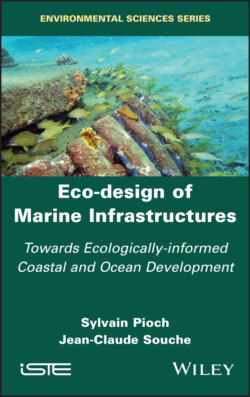Читать книгу Eco-design of Marine Infrastructures - Sylvain Pioch - Страница 13
1
Principles and Genesis of Maritime Eco-design
ОглавлениеThe global ecological crisis is concomitant with the Anthropocene, this new geological era in which humans have become the central actors of pressures on the planet (Crutzen 2006). Indeed, the recent IPBES report (IPBES 2019) makes a damning assessment of the state of biodiversity since the beginning of the industrial era two centuries ago: 75% of the land has been altered by humans (one-third of the land consuming three-quarters of the available water resources is agricultural), 66% of the oceans are threatened by humans and more than 85% of wetlands have been destroyed. It is therefore our actions on this unique planet that are holding back our own future. The logic of this observation would lead us to stop, or at least to slow down, the well-known causes of this disaster (in decreasing order): (1) artificialization and land use; (2) resource exploitation (fishing, forestry, etc.); (3) climate change; (4) pollution (plastics, chemical residues, etc.); and (5) invasive species (IPBES 2019). Thus, artificialization and land use would be our main problem. In addition to agriculture, it is the issue of urbanization and its consequences (cities, ports, mines, industries and roads) that is the most important because it leads to an artificialization of environments that is difficult to reverse. If we look at the forecasts, we can see not only a continuity but also an acceleration of global urbanization, both on the continents and at sea. No less than 60,000 billion US dollars will be invested in infrastructure between 2019 and 2040 (in the 56 countries representing 88% of the world’s GDP (Global Infrastructure Hub and Oxford Economics 2017)), more than 1.2 million km2 will be urbanized by 2030, in just 10 years, that is, an increase of 185% compared to 1970–2000 (Seto et al. 2012), and 3–4.7 million km2 of roads will be created by 2050, an increase of 25% compared to the current annual rate (Meijer et al. 2018).
This phenomenon is particularly prevalent in coastal areas, as 8 of the 10 global megacities are located on shores, such as Lagos, Tokyo, Jakarta and New York. The global maritime infrastructure footprint was approximately 32,000 km2 in 2018 (Bugnot et al. 2021). It is expected to reach 39,400 km2 by 2028, a territory equivalent to the state of Bhutan! However, the area of seascapes impacted by these structures was also estimated to be between 1 and 3.4 million km2 in 2018, with an increase of 50–70% expected by 2028, which is comparable to the global extent of urbanized areas (estimated at 0.02–1.7% of the land mass (Bugnot et al. 2021)). On the French coast, the rate of occupation doubled between 1965 and 19801. Between 2000 and 2006, no less than 6,809 ha were destroyed for the construction of harbors, dikes, embankments and other structures2. For example, in Hérault, a department in the Occitanie region, close to the Mediterranean Sea (southern France), the level of urbanization in 2015 on a narrow coastal strip of 15 km was close to 70%, with no less than three-quarters of the population concentrated there (DREAL Occitanie). In the international literature, we speak of a global “coastal squeeze”. This phrase, introduced by Doody (2004), is based on the threat to coastal development caused by the dual effect of rising sea levels and the explosion of human activities. There is an incoherence between human and the needs of our planet, especially in the urgent matter of the artificialization of natural environments, notably coastal ones. Urbanization remains the result of a development that is still too predatory of space.
Faced with the enormous challenge of a renaturation of culture (Pelt 1977), for a livable future of humankind, it becomes crucial to improve the consideration of biodiversity in territorial planning projects. We will focus here on the potential for nature-friendly planning, trying to integrate its functional needs as a fully-fledged objective in the design of infrastructures.
